 |

~ Curious And Unusual ~
- 15 -
the property plaques
a representation of the galaxy of communities
active in Rome over the past centuries
|

|
part II
plaques of foreign communities and workers' guilds
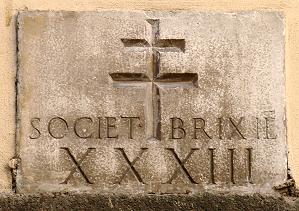 |
Once several foreign communities dwelt in Rome, either temporarily or permanently. Some of them came from Italian cities, such as Bergamo, Brescia, Florence, Siena, Ascoli Piceno, Naples, Barletta and others; nevertheless, in those days they were called nations, to remark the strong identity of each group.
Other communities, instead, came from farther lands, such as Brittany, France, Savoy, Germany, England, Scotland, Spain, Portugal, Illyria, Bohemia and so on.
← property plaque of the community (or society) from Brescia |
All these nations too used to purchase properties, which were then rented to members of the same community, who had come to the eternal city for working, studying or in piglrimage. Alternatively, homes were rented to anybody and the rent income was then used to provide with economic help fellow-countrymen away from their homeland. Associations such as congregations were very frequent among foreign communities, as well, mostly having a charity or religious inspiration, such as those described in part I.
plaque dated 1457 remembering the refurbishment →
of a hospital that belonged to the Bohemian community |
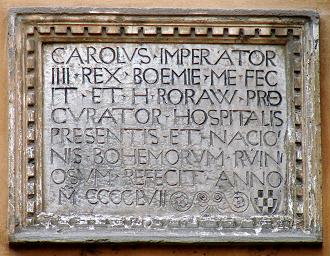 |
|
|
|
One of the oldest and most renowned organizations, still extant today, is called Archconfraternity of Pity (Arciconfraternita della Misericordia). It was founded in Florence as early as in 1244, but its 'branch' in Rome was established in 1468, by Florentine residents. Its members belonged almost exclusively to the Florentine community or nation, and among them was also artist Michelangelo. Although its original mission was to carry the sick (particularly during plagues), to collect alms for providing needy girls with a dowry, and to bury the poor when they died, in Rome the Confraternity was known especially for giving religious comfort to prisoners sentenced to death (more details can be found on page 9 of the Curious and Unusual section). |
|
The brethren wore a black cloak and hood, a colour that had been initially chosen to disguise the blood stains left by the sick on the fabric, although it was also fit for accompanying convicts on their way to the execution. As of 1540, the congregation was granted the privilege to free one sentenced prisoner each year. The Roman branch of the Archconfraternity of Pity had its seat by the church of St.John Beheaded; originally, it was called St.Mary in Petrocia, but when the congregation started to bury there the bodies of the executed, its title was changed into St.John the Baptist (who is the saint patron of Florence), that is St.John Beheaded, clearly referring to the executed, whose emblem, featured on many property plaques, is the severed head of the Baptist laid on a dish. When at the beginning of the 1500s a hospital was built next to the church, it was called St.John of Pity, as well.
Several relics concerning executions and prisoners are kept by the church, in the Historical Chamber of the congregation, which can be visited only once a year, on June 24, St.John's Day. |
|
|
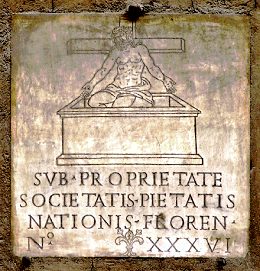 |
Another congregation established by the local Florentine nation was the Company of Pity (Compagnia della PietÓ). It was founded in Rome in 1448 after a plague, with the mission of entombing the many corpses left in the streets without a burial place. In 1519, pope Leo X (Giovanni de' Medici, from Florence, as well) had granted the congregation the right to use as its own seat the church of St.John of the Florentines, whose making was then in progress, standing at the northern end of via Giulia, in the Rione V, Ponte. Actually, most of the local Florentine community dwelt in the streets and lanes nearby this church, including some rather famous members such as Raphael, Antonio da Sangallo the Young, Benvenuto Cellini, and others. The official apparel of the Company was a plain black cloak. Once the plague was over, the colour of the cloak was changed to blue. Furthermore, the brethren had the privilege of being buried in the Company's common vault, located right in front of the main altar of the aforesaid church of St.John of the Florentines.
The emblem of the Company of Pity was an image of Christ rising from the tomb. |
|
Another organization is the Pious Congregation of the Piceni (Pio Sodalizio dei Piceni), i.e. the people from Ascoli Piceno (a town in Marche region) living in Rome. It was founded in the early 1600s by the initiative of a cardinal who came from the same region. Its saint patron was the Virgin Mary of Loreto. In 1633 the organization was first named Confraternity of the Holy House of Loreto; shortly later, in 1667, its degree was raised to Archconfraternity of the Nation of Ascoli Piceno. The organization bears its present name since 1899, when it was given a new statute. Since 1963 it is no longer of religious inspiration, having turned into a Foundation, whose mission is to help needy students from Marche region by providing them with scholarships. The properties of the Congregation include also some historical buildings, such as the house of Sixtus V (a pope from Marche, as well), located in via di Parione. In this same street the Congregation has its seat, but its activities take place mainly in some chambers annexed to the church of St.Salvatore in Lauro, in the Rione V, Ponte.
The emblem featured on the plaques is the Virgin Mary of Loreto. |
|
|
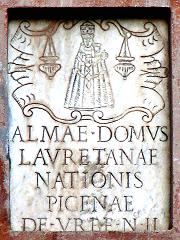 |
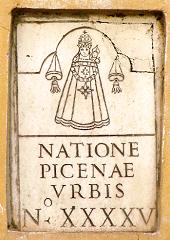 |
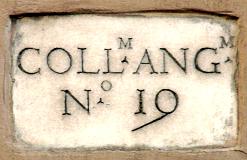 |
|
Among the 'truly' foreign communities was the English one, which already by the end of the 7th century was formed by several fellow-countrymen who had come to Rome in pilgrimage for worshipping the tomb of St.Peter (see the Rione XIV, Borgo). In 1362, a hospice was founded in the present via di Monserrato (in Rione VII, Regola), with the purpose of giving shelter to poor English pilgrims, as well as to sick ones. After the Anglican Church schism, sparked in 1535-36 by king Henry VIII (who was then excommunicated by pope Clement VII for having divorced) and the consequent repression of Catholicism in England, which grew even harsher during the reign of his daughter Elizabeth I, in 1579, i.e. during the Counter-Reformation, Gegory XIII turned the hospice into a seminary, renamed College of the English (Collegium Anglorum). |
|
In the seminary, English and Welsh students were taught Catholic-oriented philosophy and theology; those who graduated were then sent back again to their own homeland, for keeping Catholicism alive, despite the persecutions. Actually, in those years a large number of former seminarists who had studied in the College, once back in England, were put to death. Annexed to the College was a small church, that had been standing there since the 8th century, originally dedicated to the Holy Trinity of the Scots; after being rebuilt in 1575 at the expenses of the cardinal of Norfolk, to underline the meaning of the mission it was entitled to St.Thomas of Canterbury. It was then built again one more time, in 1869-73, by Virginio Vespignani. The College is still open today and acts as a seminary.
The old property plaques were very simple, only with the organization's name and the progressive number (they are among the very few that feature it in Western numerals). |
|
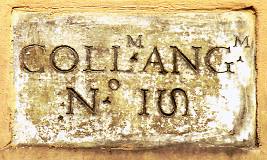 |
Many among the foreign communities ran hospitals or took care of cemeteries for the members of their own 'nation'; they did so by using the funds collected by renting their properties.
The Hospital of St.Lewis of the Gaul nation (i.e. the French community), was part of a complex that included the church presently entitled St.Lewis of the French, in the very heart of the Rione VIII (Sant'Eustachio), a large building for the clergy and, of course, the hospital itself.
Actually, a hospital named after St.Lewis and managed by the French nation for the members of their own community, was already extant in earlier times: it was annexed to a tiny church that bore the same name, located along the present via del Sudario, in the Rione VIII, as well, but at its southernmost end. |
|
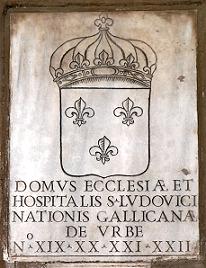
property plaque of the Hospital of
St.Lewis, of the French community,
with the French crown's fleur-de-lys |
|
|
|
When the latter turned in bad condition, in 1468 the French nation gave it away to the Abbey of Farfa, receiving in exchange a few small parish churches; the latter were replaced by the making of the aforesaid St.Lewis of the French. Then, during the first half of the 1500s, the older St.Lewis' church was handed down again, being acquired by another 'foreign' congregation, headed by the community of people from Piedmont and from Savoy: the Archconfraternity of the Holy Shroud. At first, the dedication of the church was changed into St.Helen's. Then, in 1605, it was rebuilt into its present shape, and its title changed again into Holy Shroud of the Savoyards, in memory of the Holy Shroud, the cloth kept for centuries in Savoy, and then moved to Turin (in Piedmont). The property plaques of the congregation feature an image of the Holy Shroud, held wide open (on the right →). |
|
|
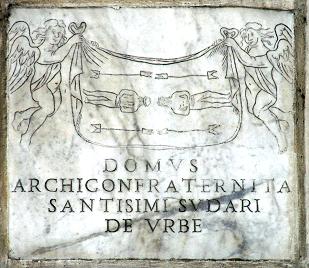
property plaque of the Archconfraternity of the
Holy Shroud, comprising Piedmontese and Savoyards,
featuring two angels that hold the open Shroud |
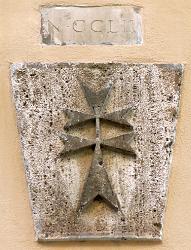 |
|
Also the Order of the Hospitallers of the Holy Spirit was French, at least its origin was. It was founded by Guy de Montpellier in 1178, and was successively approved by pope Innocent III. By the early 1200s it had spread to all the European Christian countries, but its headquarters were in Rome, at Santo Spirito in Saxia (see the Rione Borgo for details): this complex was built in the 8th century as a reception centre for pilgrims belonging to the Saxon community, but some time later, around 1200, it was turned into a hospital that took care of the sick and of abandoned children, managed by the aforesid congregation. The seal of the Order was a Lorraine cross, with two horizontal bars (a heraldic symbol whose origin is allegedly connected to Joan of Arc), featured above the doorway of several buildings, where it indicated that the Hospitallers of the Holy Spirit were the owners. The Order was economically strong, as can be told by the large number of houses it owned, especially in the surroundings of the hospital (the plaque shown on the left bears number 252). |
|
|
The Hospital of St.Anthony of the Portuguese was born out of the unification, carried out by a bishop from Portugal, of a number of charity institutions already extant in the 1400s, which had been set up for the benefit of Portuguese residents in Rome. The oldest one was the Hospital of St.Mary of BelÚm, founded no later than in 1363, somewhere near the Lateran, by a Portuguese lady. The unification led to the making, in the Campus Martius area, of a larger hospital (on the same spot where one of these facilities was already standing), and of a small adjacent church dedicated to St.Anthony. The Confraternity whose duty was to manage the hospital, was approved by the turn of the 1500s by Julius II, but a complete reorganization of its statute took place in 1540, under Paul III, and then again in 1640, under Urban VIII. By that time, the refurbishment and enlargement of the church into its present shape had just started; it was finished by the end of the century. The property plaques referring to the Hospital of St.Anthony bear the national coat of arms of Portugal. As of the second half of the 1800s, this institution began to gradually lose its religious inspiration, until it turned into the present Portuguese Institute of St.Anthony, a foundation that provides intellectuals and artists with economic help. |
|
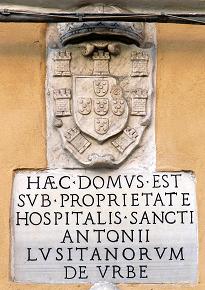 |
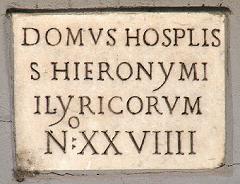 |
No less than three hospitals could be once found in the neighborhood of Ripetta river wharf, where they stood very close one to the other.
The small Hospital of St.Jerome of the Illyrians belonged to the church that bears the same name and was managed by the community of people from Illyria (or Slavonia, as it was also called in those days, corresponding to modern Croatia). They had settled by the river bank since the mid 1300s, that is earlier than the time when the local wharf became active. The Hospital was founded around 1450, to act as a hospice where pilgrims from that land could find shelter; later on it was enlarged, in order to be used as a hospital. A hostel for poor fellow-countrywomen stood nearby; they lived there not to be mistaken with prostitutes. The reason for this is that since the first half of the 16th century, the neighborhood by Ripetta wharf was Rome's 'red light district', where courtesans were allowed to run their activity only within an actual enclosure, located next to St.Jerome's complex. |
|
Side by side stood the Hospital of St.Rocco, founded around 1500 for providing assistance to those who were stricken by infectious diseases, particularly venereal ones, due to the nearby ghetto of prostitutes. In 1616 an obstetrics ward had also been opened there, where women could give birth anonymously, and for this reason was known as Hospital of the Concealed. A small, likely preexisting church was annexed to the structure; by the mid 1600s it was completely refurbished into its present shape. No property plaque referring to the Hospital of St.Rocco has survived.
Only 200 metres or yards away stood a third complex, which included the Hospital of St.James for the Incurable, founded in 1347 by a cardinal from the Colonna family, for providiing assistance to pilgrims and to poor people who could not receive adequate medical care at home, nor were admitted to any other hospital in town.
|
|
Since the beginning of the 1500s, when the 'French disease' (i.e. syphilis) broke out in Italy, St.James' Hospital started specializing in the treatment of patients stricken by this infection, as well as by any other disease that caused sores (St.James' Hospital admits only those suffering from syphilis, from sores and similar patients with incurable diseases, reads a text of the late 16th century). For this reason, in 1515 Leo X raised its rank to Arch-hospital. Among its patients was also Camillo de Lellis, a man of arms who suffered from a sore on his foot, and who later on converted to religious life, spent in favour of ill people, and founded the Company of the Servants of the Sick; for such deeds, he was proclaimed a saint, and was even chosen as the patron of patients and hospitals. The Hospital of St.James for the Incurable had an annexed chapel dedicated to the same saint, known as St.James of Agosta (or, later on, by Augusta) after the nearby Mausoleum of Octavian Augustus. Between 1580 and 1600, the hospital was enlarged, then also the chapel was improved, being replaced by the present church, built along via Lata (today's via del Corso). The emblem featured on the surviving property plaques is a pilgrim's staff with a scarf wrapped around it, in memory of St.James.
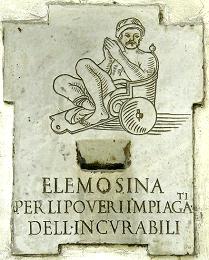 |
|
Behind the complex stood also a small church (still extant today), called St.Mary in Augusta: Then, after being rebuilt by Antonio da Sangallo the Young in 1523, at the end of a plague, its title was changed into St.Mary by Paradise Gate, maybe after a local graveyard belonging to the nearby hospital, or after the name of a small gate along Aurelian's walls, which in those days still followed the river bank, only a few metres off this spot. On its front hangs an old alms-box (← on the left), featuring a man in a weird-looking wheelchair; the money raised through donations was used 'for the poor patients suffering from sores in the hospital for the incurable', as the inscription reads.
|
|
|
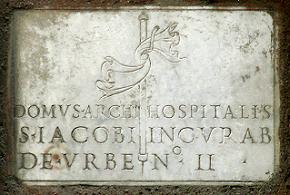
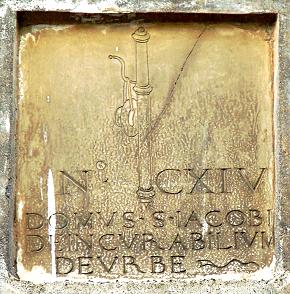 |
| The so-called Hospital of the Fools (whose full title was House or Hospital for Poor Foreigners and Madmen of the Noble City of Rome) was the first local asylum. It was founded in 1548 by three Spanish gentlemen, and had its first seat in some rooms by the church of St.Catherine of the Ropemakers, in the Rione XI, Sant'Angelo. Later on it was moved to piazza Colonna, when in 1563 pope Pius IV approved both the institution and the congregation that managed it, named Archconfraternity of St.Mary of Pity, after the title of the church that stood next to the asylum. |
|
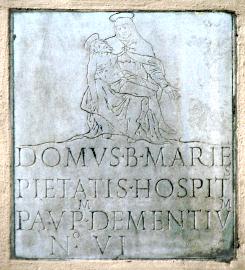 |
|
|
The emblem of this institution, featured in the very few surviving property plaques (sample on the left, in which it is mentioned as "hospital for the poor demented"), is a typical Lamentation scene, with the Virgin Mary holding the dead body of Christ. The seat of the asylum remained in piazza Colonna until around 1725, when Benedict XIII ordered the making of a larger one, near Santo Spirito Gate. |
|
|
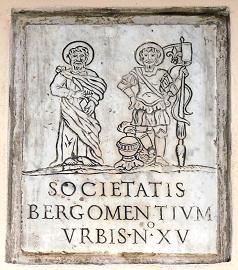 |
| The old complex was then given to the community from Bergamo, who turned the asylum into a more generic hospital for the benefit of their fellow-countrymen living in Rome, and changed the title of the small church, dedicating it to the Saints Vincent, Alexander and Bartholomew. The Archconfraternity of this community was given the name of the last two saints, who appear in the emblem featured on the banner and in the property plaques of the organization (above left). |
|
|
|
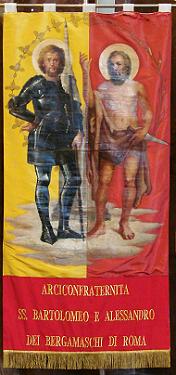 |
|
|
|
The Archconfraternity of St.Mary of Pity by the Teutonic Cemetery, which bears a name rather similar to the organization that managed the asylum, is an even older institution, dating back to the times of the Schola Francorum (school of the Franks), a complex founded by Charlemagne in 796 in the close surroundings of St.Peter's basilica, for the benefit of the Roman community of his fellow-countrymen, the Franks; it included a hospice, a church dedicated to the Saviour and a small cemetery where the community members used to be buried. When Charlemagne's empire came to an end, the management of this complex was handed down to St.Peter's basilica; but later on, during the Avignon papacy period, it fell into complete carelessness. During the 1400s, pope Martin V and his successors gave new life to this institution, as the Teutonic community in Rome was still rather numerous. The cemetery was enlarged, surrounded by a boundary wall, and guarded by a warden who lived on the spot. During the plague in 1448, the local community founded a congregation with the purpose of giving a burial place to all Germans who died in Rome (in those days the Kingdom of Germany included also present Austria and the Netherlands). The church and the hospice were rebuilt, as well, taking the name of St.Mary of Pity. Also in this case the emblem of the congregation was a Lamentation. When by the early 1500s the church of St.Mary of Souls was founded, to become the national Teutonic church in Rome, the importance of the ancient complex by St.Peter's once again declined. In 1876 Pius IX founded there a seminary for German-speaking priests, the Teutonic College of St.Mary by the Cemetery. Presently, its location is within the territory of the Vatican State, but a couple of property plaques are still extant in Rome's central districts. |
|
Finally, a third kind of organization, whom some buildings belonged to, were the workers' guilds, similar to modern labour unions, whose members had specific jobs. These institutions existed in Rome since the Republican age, when they were known as collegia, born with the aim to provide the members with mutual assistance and to protect their common interests; they were revived as of the 12th century, when they were called Universities, or Arts. Their seat was usually either by a church or by an oratory, sometimes built for this purpose with the association's funds (such as the sample on the right); in other cases, instead, the building preexisted the guild, to whom its use was granted by the pope.
dedication inscription above the doorway of the small church of →
the Saints Benedict and Scolastica, belonging to the University of Pork-butchers |
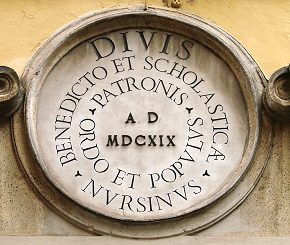 |
|
property plaques of the University of Blacksmiths
|
|
Starting from the 16th century, no less than nine Universities extant in Rome, namely those of Middlemen, Merchants, Cheesemongers, Greengrocers, Vegetable gardeners, Millers, Pasta-makers, Poulterers and Shoemakers, aggregated to the Archconfraternity of St.Mary of the Orchard, mentioned in part I; according to tradition, also those of the Winegrowers, Barrel-makers and Dry chestnut sellers did the same.
Others, instead, such as those of Pork-butchers, of Carpenters, etc., remained autonomous; among them was also the University of Goldsmiths, Blacksmiths and Saddlemakers, originally born as a single guild. |
|
|
Then, in 1404, they were split into three separate guilds; nevertheless, all three of them kept the same church of reference, San Salvatore alle Coppelle (built in 1196), and their saint patron, St.Eligius from Noyon (a bishop and a goldsmith, who lived in the 7th century). By the early 1500s, Blacksmiths and Goldsmiths built at their own expenses two new churches for their own guilds, both of which were dedicated to the same saint, therefore bearing the titles of St.Eligius of the Blacksmiths (located in the Rione XII, Ripa, right in front of St.John Beheaded's church, the seat of the Archconfraternity of Pity), and St.Eligius of the Goldsmiths (designed by young Raphael, in the Rione VII, Regola). Near both churches, houses with property plaques can be found: those of the University of Blacksmiths (shown above) feature a hammer and an anvil, while the ones of the University of Goldsmiths and Silversmiths (right) have only text. |
|
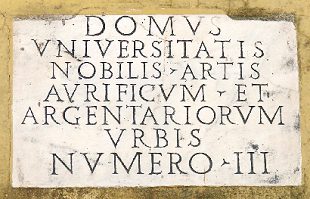
property plaque of the University of Goldsmiths |
The University of Carpenters was established in 1525; it included a large number of subcategories, such as cabinet makers, carvers, turners, chair-makers, clog-makers, keg-makers, drum-makers, cymbal-makers, coach-makers, boat-makers, mill-makers (who built the floating mills, mentioned in the page about river floods), bellows-makers, packsaddle-makers and others. Its seat was St.Gregory by Ripetta, a small church founded in 1527 by the University of Masons, which also hosted the carpenters' guild.
A few years later, in 1540, thirty craftsmen founded the Confraternity of St.Joseph of the Carpenters, whose seat was by the church of St.Peter by the Prison, so called because it stood right over the Mamertine Prison, where according to tradition St.Peter and St.Paul had been held as convicts; the congregation performed several types of charity activities. |
|
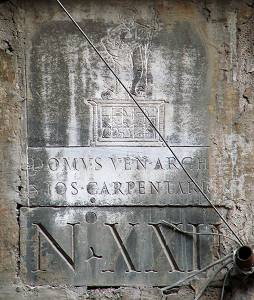
↑ property plaque of the Archconfraternity
of St.Joseph of the Carpenters;
the saint and the Mamertine Prison
are shown on the right, enlarged → |
| Around 1600, the latter church was rebuilt and dedicated to St.Joseph. On that occasion, the University of Carpenters united with the aforesaid congregation, whose degree had been raised to Archconfraternity, so that St.Joseph of the Carpenters by the Roman Forum became the reference church also of the carpenters' guild. The property plaque shown on the left is one of the very scarce ones still extant, unfortunately in a bad state of preservation: it features St.Joseph standing over a simplified representation of the Mamertine Prison, where St.Peter and St.Paul are seen behind the bars, carrying their traditional attributes (the keys and a sword, respectively). |
|
|
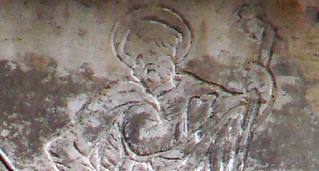
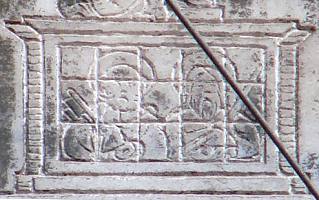 |
go back to part I


